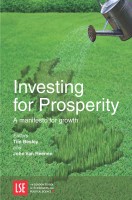 What institutions and policies are needed to sustain UK economic growth in the dynamic world economy of the twenty-first century? After years of inadequate investment in skills, infrastructure and innovation, there are longstanding structural weaknesses in the economy, all rooted in a failure to achieve stable planning, strategic vision and a political consensus on the right policy framework to support growth. This must change if we are to meet our current challenges and more that may arise in the future.
What institutions and policies are needed to sustain UK economic growth in the dynamic world economy of the twenty-first century? After years of inadequate investment in skills, infrastructure and innovation, there are longstanding structural weaknesses in the economy, all rooted in a failure to achieve stable planning, strategic vision and a political consensus on the right policy framework to support growth. This must change if we are to meet our current challenges and more that may arise in the future.
Despite the current recession gloom, the UK has many assets that can be mobilized to its advantage. It has strong rule of law, generally competitive product markets, flexible labour markets and a world-class university system. It has strengths in many key sectors, with cutting-edge firms in both manufacturing and services. These and other assets helped to reverse the UK’s relative economic decline over the century before 1980.
This book, based on the work of the LSE Growth Commission, argues that the UK should build on these strengths and proposes how we can address the inadequate institutional structures that have deterred long-term investment to support our future prosperity.
Review:
This book is the outcome of what came to be known as the LSE Growth Commission, launched in 2011 by Tim Besley and John van Reenen, both professors at the London School of Economics’ Centre for Economic Performance, in partnership with the Institute for Government. It was born very much out of the wish of the academics to rise above the austerity debate that followed the financial crisis of 2007/8 and look instead at the conditions under which the UK could return to strong and sustainable long-term growth. The Commission’s work was facilitated by a series of open ‘evidence gathering’ sessions, akin to those of Select Committees of Parliament. I myself attended a couple where ‘experts’ were being questioned by the appointed Commissioners.
A couple of years on, with all the proceedings published, interim reports and final conclusions already in the public domain, the book has converted the sessions and the evidence gathering into neat chapters summarising the issues and outlining clearly and convincingly what needs to be done. Although growth is resuming now, it is unbalanced and since the recession started we have seen a collapse in our productivity performance. As a former civil servant myself I know that the government too often works in silos and lacks, as the authors have discovered, “A stable machinery at the centre.” Whitehall is therefore rarely given the chance to focus on the long term. My previous department, BIS, which contributed to the Commission’s work, has in fairness produced a series of industrial policy documents through the years and has supported various measures that the Commission would approve of – such as the Small Business Bank, the Green Investment Bank and the forthcoming ring-fencing of retail from investment banking activities. But problems persist. We still suffer from low levels of both private and public investment (public capital spending halved to £26.7b between 2009/10 and 2011/12). At 1.8% of GDP, our R&D spending is one of the lowest in the developed world. Lack of finance for SMEs and for innovation is holding us back. Investment in skills lacks coherence. Clearly much more needs to be done to restore long-term growth.
But what exactly? The UK managed to catch up with France and Germany in the decades since the late 1970s by liberalising, improving competition and opening up its markets and by reducing bureaucracy and state control. By 2007 the UK had overtaken both France’s and Germany’s GDP per capita and narrowed the gap with the US, thanks to an increase in the employment rate and in productivity growth which remained impressive even taking finance out of the calculation. Maybe therefore carrying on with further deregulation and reducing government spending will do the trick? The authors disagree. They point to evidence that the size of the state, looking across countries, is not a major determinant of growth. Instead they argue that the state now needs to think more long term, become more proactive and innovative itself, setting up institutions empowered to use whatever means available to them to ensure that the much-needed investment in rail, roads, runways, energy, finance and skills infrastructure can actually materialise. They are quite descriptive and refreshingly detailed in their recommendations.
In some areas, particularly on public infrastructure, the Government is already making the right noises. It needs to do more. At the very least it should use this very sensible report as a reference manual.
— Vicky Pryce

